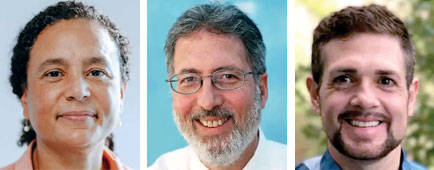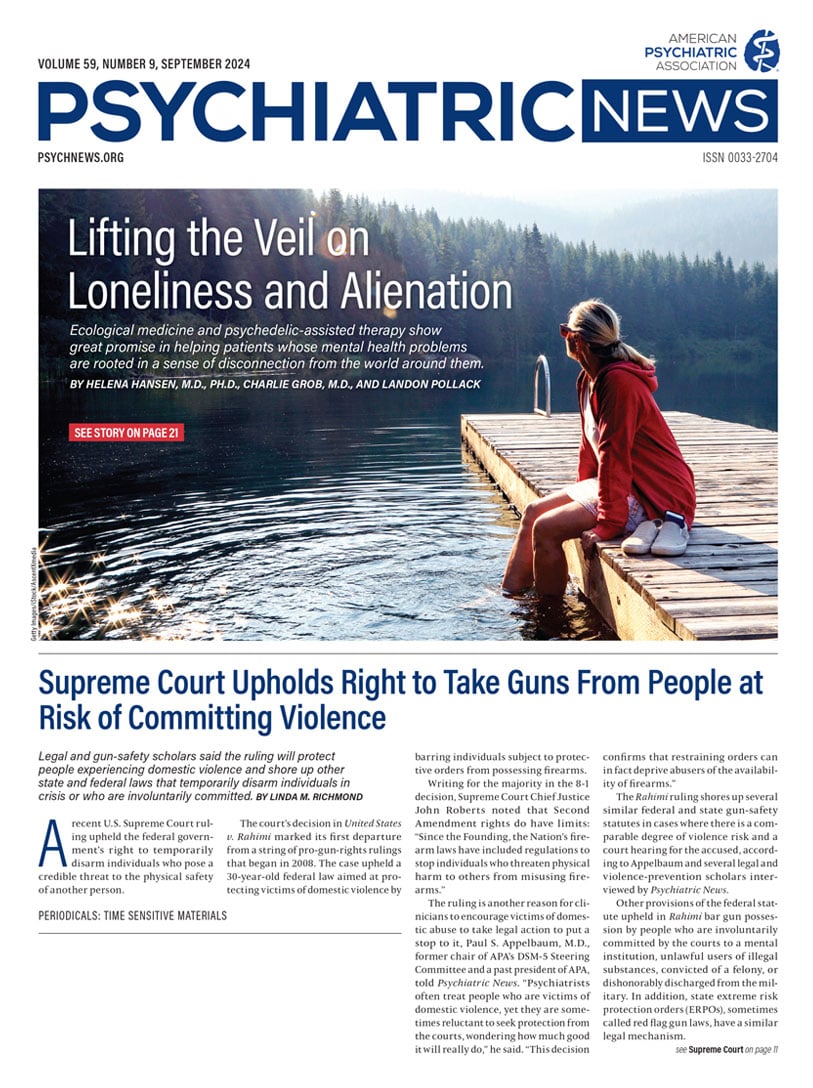With overdose deaths and suicides at unprecedented rates in the United States, and loneliness a national epidemic affecting nearly half of U.S. adults, it’s time for mental health care to address the profound sense of disconnection and alienation people are experiencing. There is broad and growing appreciation for the need for new paradigms and novel treatment models, as current treatments are limited in their scope and efficacy. Two areas of renewed interest—ecological medicine and psychedelic-assisted therapy—show great promise, and combining these modalities may be even more powerful.
At their core, both ecological medicine and psychedelic therapy are about reconnection—with the living ecosystem surrounding us and within each individual as part of that larger whole. These are components of a powerful vision for reinventing biomedicine, where rather than continuing to focus inward, at the exclusively molecular or neuronal level, we turn our focus outward, to how we can foster connections with each other and with the natural world. And, where necessary, we bring the natural world of plants and animals into the biomedical clinic.
Understanding Ecological Medicine
While a biopsychosocial approach to human well-being in itself is not new, ecological medicine is a relatively new area of inquiry, involving the structured and deliberate use of connectedness and interaction with plants, animals, and other species to generate a therapeutic effect for individuals. Embedded in ecological medicine is a sense of mutuality and reciprocity—it is not about extracting and exploiting plants and animals but recognizing a shared connection with them. As part of the underlying therapeutic process, humans participating in ecological medicine begin to understand that other species are worthy of respect and move toward more symbiotic relations.
This recognition serves to counteract some of the societal elements contributing to society’s epidemic of mental health problems. Overdose deaths, suicides, and many other mental health related indicators have increased significantly in recent years, pointing to a profound sense of disconnection—social disconnection, loneliness, and disconnection from the living environment around us. The U.S. surgeon general, citing record numbers of Americans who report social isolation on national surveys, has declared an “epidemic of loneliness.” Ecological medicine works on an individual level to help foster a sense of connectedness and belonging in relation to other species, and more broadly to foster a sense of reciprocity, responsibility, and mutuality when it comes to other living things. In that way, it also addresses an underlying cultural problem, which is an extractive attitude toward the planet and its species. Our lack of care for other living things has led to record rates of extinction—to human beings’ great detriment, because we mutually rely on other species.
There is evidence that spending time outdoors in natural spaces leads to measurable and long-lasting physical and mental health benefits, including improved cognitive flexibility, lower stress, and reduced risk of psychiatric disorders. A recent study reported that nature connectedness is four times more powerful as a predictor of happiness than socioeconomic status. Guided interactions with plants and animals have demonstrated meaningful psychological benefits, and there is data on the health benefits of community gardening and urban farming. That said, much more research is needed. The mechanisms by which ecological medicine works have been difficult to study in a precise way. What does it mean, for instance, to provide a “dose” of nature connectedness? We need systematic studies of connection with plants and animals and guided interactions with other species in a clinical setting.
To that end, the UCLA Semel Institute for Neuroscience and Human Behavior’s Ecological Medicine and Psychedelic Studies Initiative, known as Project ReConnect (reconnect.ucla.edu), is creating a living laboratory to serve as a dedicated space where we can begin a deeper investigation. Populated by plants and pollinators, this private rooftop facility will allow for rigorous and careful study of nature connection and guided interactions with plants and native animals, including the effects of those interactions on mental health and other health indicators. This laboratory will be accessible to a diverse array of researchers, ranging from neuroimagers and bench neuroscientists to clinical researchers and social scientists, so we anticipate a robust, multidisciplinary exploration of how ecological medicine works and what its practical applications might look like. There are so many questions we can begin to answer in this kind of controlled environment.
We are interested in employing the benefits of UCLA’s Ecological Medicine and Psychedelic Studies Initiative in multiple directions, including importing green spaces and other species into biomedical environments in a way that is beneficial—that is, reciprocal—to native species; relocating clinical work into the community in natural settings, such as community gardens and urban farms; and bringing nature connectedness to populations with different limitations through mediated reality (virtual and augmented reality), social robotics, and other forms of technology.
Combining Psychedelic Therapy With Ecological Medicine
The intersection between ecological medicine and psychedelic studies dates back to the origins of psychedelic medicine. In the Indigenous cultures that have used psychedelic plant medicines for centuries, natural spaces have always been the setting for administration of these compounds. Many of the laboratory-synthesized psychedelics we know today were discovered in the natural world and derived from plants and animals.
In studying the use of ayahuasca in the Brazilian Amazon, researchers found ceremony, community, and natural surroundings to be essential components. In that context, people with addictive disorders resonated with these interwoven aspects of the experience—i.e., the peer support and the proximity of the natural world all around them. Participants emerged with a reduced compulsion to continue to take substances and had a much greater appreciation of the environment; some of them became environmental activists as a result of these experiences. We have much to learn from Indigenous practices, including their use of psychedelics and how they structure experiences optimally to support desired outcomes.
After decades of neglect and inactivity, the field of psychedelic studies has surged forward in recent years, generating considerable interest and enthusiasm within mainstream clinical psychiatry research, with rapid expansion of psychedelic research in academic medical centers across the country and special issues of leading clinical journals on psychedelics, including a forthcoming special issue of the American Journal of Psychiatry. In particular, promising studies have been conducted with the classic psychedelic compound psilocybin (derived from species of hallucinogenic mushrooms), treating patient populations that are often considered refractory and non-responsive to conventional therapies. These areas include demoralization and existential anxiety in individuals close to the end of life, as well as patients with severe alcohol use disorder, cocaine addiction, cigarette addiction, obsessive-compulsive disorder, chronic posttraumatic stress disorder, and treatment-resistant major depressive disorder. Further studies will examine responses to the application of this novel therapeutic model to some of the most severe and treatment-refractory conditions modern psychiatry struggles with, including serious and potentially life-threatening eating disorders. Many of these investigations exploring the clinical utility of psychedelics have reported very encouraging outcomes, with degrees of clinical improvement often far exceeding expected responses to long-established conventional treatment models.
Notable advances have been made over the past two decades, including furthering our understanding of the critical importance of “set and setting” and how these concepts can be harnessed to enhance the process and outcome of psychedelic psychotherapy. The idea of set and setting posits that the effects of psychedelics depend on the mindset, personality, preparation, expectation, and intention of the person having the experience, along with the physical, social, and cultural environment where the experience takes place. Preliminary studies combining psychedelic medication with nature contact have shown synergistic improvements in mental health. But there is still considerable work to be done in furthering our understanding and ability to optimize the likelihood of positive clinical outcomes and minimize the possibility of adverse effects from psychedelic therapies. This will be particularly helpful when it comes to establishing effective safety and ethical parameters.
Looking to the Future
After years of quiescence following the political and cultural turmoil of the 1960s, there has been a growing sense that our society—and our profession—is ready to explore and better understand connection-focused treatment models such as ecological medicine and psychedelic-assisted therapy. While psychedelics have the potential to facilitate profound positive change on both the individual and collective levels, they must be administered with patients who have the right (mind)set and are in the right setting. Ecological medicine, with its established positive impact on mental health, is a promising route to establishing a setting that will enhance the mental health benefits of psychedelic therapies. Psychedelics are not magic bullets, and to support the likelihood of establishing effective treatments that will be of value to the patients coming to us for care and amelioration of suffering, ultimately we must depend on how well we have learned from the lessons of the past about the crucial role of set and setting.
In addition, it is imperative to remedy the well-documented racial-ethnic inequities in access to psychedelic clinical trials and treatments. Ironically, psychedelic compounds whose therapeutic uses were first discovered by Indigenous people, such as psilocybin, are now largely biomedically unavailable in Indigenous communities. In relation to ecological medicine, urban low-income and/or Black, Latinx, and Indigenous populations disproportionately live in neighborhoods with the least canopy cover and greenspace, and this is associated with poor health. Therefore, access to and participation in the development of psychedelic therapies and ecological medicine are critically important for health equity.
The good news is that recent trials of psychedelics have shown efficacy across several different diagnoses. We believe that the underlying cause when it comes to environmental- and relationship-based drivers of mental health problems is often the same sense of disconnection and alienation. It is very rare to find someone who is deep into addiction and suffering who does not also face other challenges that qualify as comorbid diagnoses, as well as underlying problems with relationships, a sense of loneliness, trauma, and disconnection. Endemic alienation is the driver of what we see as different manifestations of mental health conditions, and research combining ecological medicine and psychedelics aims to get at the root cause.
Ecological medicine at its best is focused on symbiosis and reciprocity—for individual health and natural system health—in a self-sustaining cycle. It supports recognition of interconnectedness and unity. Although some psychedelics research has been criticized for embracing a psychospiritual model, many people who undergo psychedelic therapy report experiencing a sense of interconnection and oneness.
The essence of spirituality is connectedness with the great collective—with plant life, animals, and other life forms. These experiences facilitate states of unity, a powerful sense of awe and reverence, fitting the definition of a profound mystical experience, whether it is substance-induced or spontaneous. Maximizing that sense of connection by combining ecological medicine and psychedelic studies appears to hold great promise to help ease the endemic alienation leading to so much mental suffering today. ■


